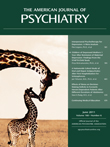Response to Vieweg and Hasnain Letter
To the Editor: We appreciate the interest of Drs. Vieweg and Hasnain in our work and the opportunity to be explicit about what the goal of our study was. Drs. Vieweg and Hasnain are concerned that our data may be misconstrued, claiming that we “may have inferred conclusions about ziprasidone and QTc interval prolongation that are not supported by the data.” However, as indicated in our title and throughout the article (1), our goal was to look at comparative rates of nonsuicide mortality. The conclusion of our abstract is explicit: “the study was neither powered nor designed to examine the risk of rare events like torsade de pointes.” The article ends with the following:
However, this study was not powered to examine the risk of an extremely rare event like torsade de pointes, which would have required a sample size that was orders of magnitude larger than the 18,154 patients examined in ZODIAC and would have required intensive and prolonged cardiac monitoring, which would have been at odds with the study's goal of adhering to routine clinical care.
Thus, we were not studying QTc prolongation and indeed did not even measure it. There has never been any question that ziprasidone prolongs QTc, based on Pfizer's clinical data (2). Our goal was to see whether that led to an increase in nonsuicide mortality.
Finally, Drs. Vieweg and Hasnain propose looking at case reports as a way to answer the question they pose, referencing two that they published. While case reports have their place in studying adverse drug reactions (3, 4), they could not have answered the question we were addressing. Furthermore, it is important to keep in mind their substantial limitations. As has often been stated, “The plural of anecdote is not data.”
1. : Comparative mortality associated with ziprasidone and olanzapine in real-world use among 18,154 patients with schizophrenia: the Ziprasidone Observational Study of Cardiac Outcomes (ZODIAC). Am J Psychiatry 2011; 168:193–201Link, Google Scholar
2. : A randomized evaluation of the effects of six antipsychotic agents on QTc, in the absence and presence of metabolic inhibition. J Clin Psychopharmacol 2004; 24:62–69Crossref, Medline, Google Scholar
3. : Spontaneous reporting in the United States, in Pharmacoepidemiology, 4th ed. Edited by Strom BL. New York, John Wiley & Sons, 2005Google Scholar
4. : Disproportionality analyses of spontaneous reports. Pharmacoepidemiol Drug Saf 2004; 13:503–504Crossref, Medline, Google Scholar



